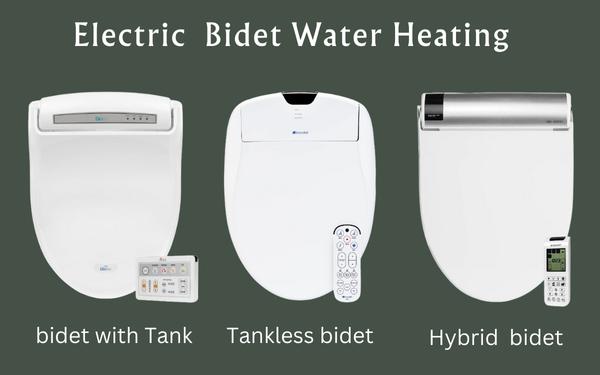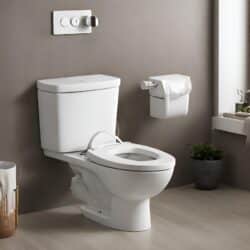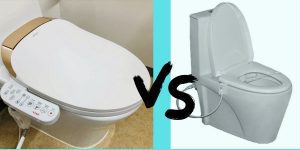Electric Warm Water Bidet: Tank vs Tankless vs Hybrid

Exploring the world of electric bidets reveals one of their most coveted features: the ability to deliver warm water for an enhanced cleaning experience. Curious about how electric bidets achieve this comfort?
Delve into our article on making your bidet water warm to uncover the mechanisms behind the warmth. Additionally, understanding the ideal temperature of a bidet is crucial for optimizing your comfort. Learn more about it in our insightful guide here.
For those interested in the broader aspects of electric bidets, including their power usage and associated electric costs, our comprehensive analysis offers valuable insights.
If you’re contemplating the differences between electric and non-electric bidets and seeking pros and cons to inform your decision, our detailed comparison can guide your exploration.
Discover the warmth and efficiency electric bidets bring to your bathroom routine through these informative links.
Electric Warm Water bidet explain How it works
The first thing to note is that there are two types of electric bidets: tank and tankless. Tank bidets have a built-in water reservoir that holds and heats the water. Tankless bidets, on the other hand, heat the water on demand as it flows through the unit. Regardless of the type of electric bidet, the heating mechanism is essentially the same.
Electric bidets use a heating element, typically made of metal, to warm the water. The heating element is located either in the water tank or in the water flow path. When the bidet is turned on, the heating element is activated, and electricity flows through it, generating heat. The heat generated by the heating element warms the water as it passes through the unit, providing the user with warm water for cleaning.
The temperature of the water can be adjusted to suit individual preferences. Many electric bidets come with a temperature control feature that allows users to set the temperature of the water. Some models even have multiple temperature settings, ranging from warm to hot.
In addition to the heating element, electric bidets also have a thermostat to regulate the temperature of the water. The thermostat ensures the water temperature stays within a safe and comfortable range.
how do electric bidets get warm water
Electric bidets use these three methods to warm up water and to keep the warm water stored:
- Warm water tank method
- On-demand heating method
- Hybrid heating method
Tank Bidet Water Heater/Water reservoir
Tank bidets have a built-in water reservoir that holds and heats the water for future use. The tank is usually located at the back of the bidet and can hold anywhere from 0.5 to 2 litres of water. The tank is typically made of plastic or ceramic and is insulated to help retain the heat. Heated reservoir-type bidets usually have a temperature range of between 95-105°F (35-40°C).
When the bidet is turned on, the water from the tank is released and flows through the unit. As the water flows, it passes through a heating element, which heats it to the desired temperature. Once the water has been heated, it is then sprayed onto the user for cleaning.
Product Examples: Bio bidet 1000 Supreme, Bio bidet 600 Ultimate, and TOTO C200 Washlets SKU: SW2043 are bidets with tanks reservoir.
Advantages of Tank bidet water heater
- Provide warm water instantly: One of the advantages of using a tank bidet is that it can provide warm water instantly. Because the water is already heated in the tank, there is no need to wait for the water to warm up, as there is with electric bidets. This can be particularly useful for people who need to use the bathroom quickly, such as those with mobility issues.
- Easy to Install and affordable: Another advantage of tank bidets is that they are relatively easy to install and affordable. They do not require any electrical wiring or plumbing modifications, and they can be connected directly to the existing water supply. This can make them a more affordable option compared to electric bidets.
Disadvantages of Tank bidet water Heater
There also some potential disadvantages to using a tank bidet.
- Limited water supply: One issue is that the warm water supply is limited to the size of the tank. If the user takes a long time to use the bidet, the warm water may run out, and they may have to wait for the tank to refill and reheat.
- Sloped Design: Secondly, a reservoir-type heater takes up more space in the toilet seat, which may cause a sloped seat, be uncomfortable for some people, and be an aesthetic issue.
- More Power need for on demand supply: It consumes more power and needs electricity to keep the water warm all day; otherwise, you have to wait for the warm water.
Tankless Bidet/on-demand heating method
Tankless type bidet are higher-end electric bidet seats, usually in the range of $700 or more. They are considered luxury bidets and are considered more expensive than heated reservoir-type bidets.
Tankless bidets, also known as on-demand bidets, heat the water as it flows through the unit. They do not have a built-in water reservoir; instead, they use a heating element to heat the water on demand. When the user turns on the bidet, cold water from the existing water supply is directed through the unit and over the heating element. The heating element quickly heats the water to the desired temperature, and the warm water is then sprayed onto the user for cleaning.
Product Example: Brondell Swash 1400, Bio bidet Discovery DLS, Toto S550E WASHLET – Classic Trim
Advantages of on-demand heating/Tankless bidet
- Unlimited warm water: One of the advantages of using a tankless bidet is that it can provide unlimited warm water. Because the bidet heats the water on demand, there is no limit to how much warm water it can provide.
- Useful for multiple people: This can be particularly useful for people who take longer to use the bathroom or for households with multiple people who use the bidet frequently.
- Energy Efficient: Another advantage of tankless bidets is that they are energy-efficient. Because they only heat the water when it is needed, they use less energy than tank bidets, which need to heat and maintain the water in the tank constantly. This can reduce energy costs and make them a more environmentally friendly option.
- Great for feminine hygiene: Having unlimited warm water means you can clean both the front and back in the same session and perform deeper cleaning sessions that take longer.
- Sleek design: These bidets tend to have a flat surface, making them look more sleek and comfortable than bidets with a sloping design.
- Suitable for Rental property : Tankless water heaters do not require any permanent alterations to the property.
Disadvantages of instant heating/Tankless bidet
- However, there are also some potential disadvantages to using a tankless bidet.
- Higher cost: As this type of water heater combines the features of a heated reservoir and instantaneous heating technology, it can be more expensive than the other water heaters.
- Take Time: One issue is that the warm water may take a few seconds to reach the desired temperature. This is because the heating element needs time to heat up the water as it flows through the unit.
- Require more maintenance: Another issue is that tankless bidets may require more maintenance than other types of bidets. This is because the heating element can become clogged with mineral buildup over time, which can affect its performance and lifespan.
hybrid Heating method
Hybrid bidets are a combination of two types of technology and are generally more expensive than other bidets.
They keep a small amount of warm water in reserve and heat the rest as it flows through the nozzle. However, the amount of warm water available is usually only an extra 20 to 30 seconds, which may be insignificant.
Product Example: Bio bidet 2000 Bliss, Bio bidet A7 Aura, Brondell Swash Select DR802
Advantages of Hybrid Type Heating Bidets:
- Energy efficient: Hybrid-type heating bidets use a combination of instantaneous and reservoir heating mechanisms to heat the water. This makes them more energy-efficient than traditional electric bidets, which consume more electricity to heat the water.
- Sleek Design: One advantage of hybrid bidets is their sleek and comfortable design, as they don’t have a large water reservoir and therefore don’t have a sloping seat.
- Longer Session of warm water: With hybrid-type heating bidets, you don’t have to worry about running out of hot water (not all models). The water is heated on demand, ensuring that you always have a continuous supply of warm water.
- Easy to install: Hybrid-type heating bidets are easy to install, and you don’t need to hire a professional plumber to do the job. They can be installed by anyone who has basic plumbing knowledge and tools.
- Customizable features: Hybrid-type heating bidets come with various features, such as water temperature, water pressure, and nozzle position, allowing you to personalize your bidet experience.
Disadvantages of Hybrid Type Heating Bidets:
- Cost: Hybrid-type heating bidets are more expensive than traditional non-electric bidets. This is due to the additional technology required to heat the water on demand.
- Requires electricity: Hybrid-type heating bidets require electricity to operate, which means they may not be suitable for areas with unreliable or limited power supply.
- Water pressure: The water pressure from hybrid-type heating bidets may not be as strong as that of traditional non-electric bidets. This can be a concern for those who prefer a stronger water stream.
- Maintenance: Hybrid-type heating bidets require regular maintenance to ensure that they are functioning correctly. This includes descaling the water heater and cleaning the nozzle regularly. Failure to maintain the bidet can lead to malfunction and damage to the bidet.
- Small amount of extra water: Providing only a small amount of extra warm water.
Takeaway- Electric bidet water heating methods
In conclusion, electric warm water bidets offer a comfortable and hygienic bathroom experience by providing warm water for cleaning.
With various options available, including tank, tankless, and hybrid systems, consumers can choose the best solution based on their preferences and needs. While each system has its pros and cons, factors such as budget, energy efficiency, ease of installation, and maintenance should be taken into consideration when making a decision.
Ultimately, incorporating an electric warm water bidet into your bathroom setup can greatly enhance your overall comfort and cleanliness.
FAQs: Electric bidet water heating methods
How do electric warm water bidets work?
Electric bidets use a heating element to warm up the water, which can be adjusted according to user preference. They can be tank, tankless, or hybrid systems, each with its advantages and disadvantages.
What are the advantages of tank bidet water heaters?
Tank bidets provide instant warm water, are easy to install, and are relatively affordable.
What are the disadvantages of tank bidet water heaters?
Limited water supply, sloped design, and higher power consumption for maintaining water temperature.
What are the advantages of on-demand heating/tankless bidets?
Unlimited warm water, energy efficiency, sleek design, and suitability for rental properties.
What are the disadvantages of instant heating/tankless bidets?
Higher cost, delayed warm water supply, and potential maintenance issues due to mineral buildup.
What are the advantages of hybrid type heating bidets?
Energy efficiency, sleek design, longer sessions of warm water, easy installation, and customizable features.
What are the disadvantages of hybrid type heating bidets?
Higher cost, reliance on electricity, potentially weaker water pressure, and regular maintenance requirements. Additionally, they provide only a small amount of extra warm water compared to tankless bidets.



